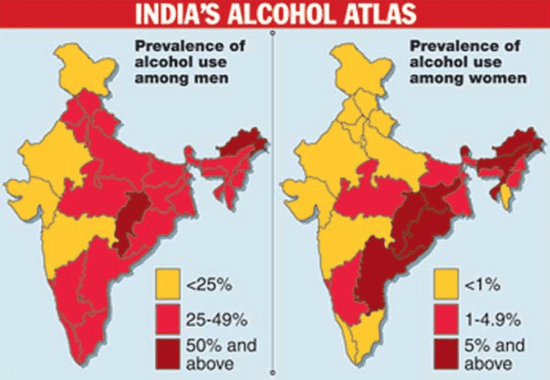Unlike in the West, documentation on the overall effects of alcohol, has been poor in India.
Its increasing availability and use in the last decade has also brought myriad problems affecting both the individual and society.
Efforts to tackle the problem have been piecemeal and fragmented resulting in lack of direction and focus.
Consumption Patterns
- In the total spectrum of alcohol consumption in the country only about 50% is documented and the rest is undocumented. Variations in taxation policies have led to a grey market as spurious and smuggled liquor is easily available to the population.
- No precise estimates can be made on the prevalence of alcohol use in India due to variations in methodological issues in the published literature. However, a collective review reveals that 30% of adult men consume alcohol and among women, the estimated prevalence is less than 3% giving a male to female ratio of 10:1

The majority chooses to live alcohol free
- Hospital-based studies and population-based studies report increasing use of alcohol in the country. The use is found to be high in the north-eastern and southern states of India.
- From a policy perspective, it has been identified that India has nearly 62 million alcohol users, 17% of whom are alcohol dependents.
- The use of alcohol is increasing disproportionately in the urban and rural areas. Interestingly the transitional towns and semi-urban areas are entering the spiraling loop of alcohol use.
- Commonly IMFL and beer are preferred in urban areas and in younger age groups, while country-made liquor and rum are common in rural India. Homemade brews continue to be popular in select communities especially in north-eastern parts of India, Goa, etc.
- The available data reveals that pattern of alcohol use is directly associated with education, social class and occupation. Alcohol use is high in poor communities, contributing to increasing expenditure on alcohol on one hand and increasing resources spent for managing alcohol-related problems on the other.
- The average age of initiation to alcohol use has reduced from 23 years during the 1980s to 14 years in recent years. Once begun, the average duration generally lasts far more than 10 years. What starts as an experimentation and pleasure seeking usually becomes an addictive process.
- The amount of alcohol consumed increases with age and duration. Social users generally graduate into hazardous and pathological alcohol consumption over a period of time.
- The place of alcohol use has also been changing over a period of time. The commonest places of alcohol intake are pubs/bars and retail outlets (to the extent of 60 to 70%) in urban areas. In the rural areas the local outlets (arrack shop and wine stores) are the commonest places of alcohol use.
- The reasons of use of alcohol have not been adequately documented. Alcohol use usually starts in social circles for pleasure seeking and companionship, progressing later into isolated and regular alcohol intake. In the large majority of poor communities, alcohol is reportedly consumed to overcome fatigue, stress, aches and pains. The social constructs of alcohol use have largely been linked to masculinity, domination, power equations, corporate culture and others.
- The emerging trend includes – initiation of alcohol use at an early age, greater consumption among women, greater permeation in rural and semi-urban areas, increasing preference for products with high alcohol content, hazardous and harmful alcohol intake.
Hi,
Could you please mention the sources of data too? I wanted to do some analysis on alcohol related patterns.
Thanks
Prateek
Hi Prateek!
Thanks a lot for your comment.
It’s great that you are using the content of our website. I’ll put you in touch with Johnson directly, so that you can discuss data sources. Johnson will be able to guide you in your further research.
His blogs series about alcohol India was part of a comprehensive background paper he wrote.
Best,
maik
Hi,
Could You please mention the sources of data? I might need it for my research.
Thanks a lot
Jessica